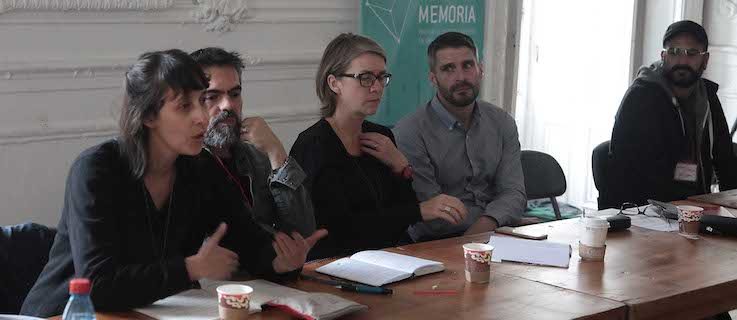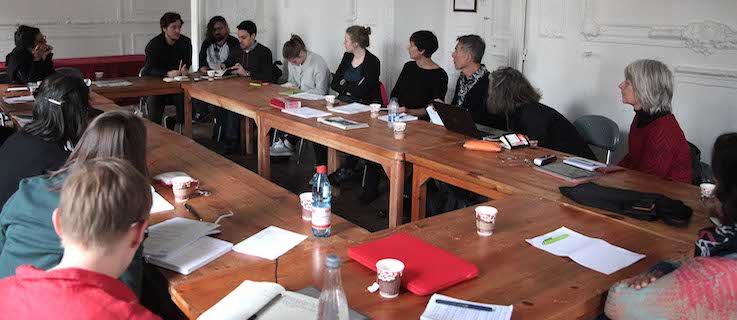In the beginning there were questions. Countless questions, about memory and oblivion, something that became very clear during the first moments of the inauguration of The Future of Memory, when key participants of this project met for the first time to talk about their worries and concerns.
-
 Photo: © Felipe Moreno
Photo: © Felipe Moreno
-
 Photo: © Felipe Moreno
Photo: © Felipe Moreno
-
 Photo: © Felipe Moreno
Photo: © Felipe Moreno
The opening of "The Future of Memory", a regional project initiated by the Goethe-Institut, took place in Bogotá on March 29th. On that day, the co-curators of the project – coming from various South American cities such as Bogotá, Buenos Aires, Montevideo, Rio de Janeiro, Sao Paulo and Santiago de Chile– met with the organisers and coordinators at the headquarters of the art lab Mapa Teatro, directed by Heidi and Rolf Abderhalden.
Indirectly, the venue itself revealed some of the questions and ideas behind the project, and this will undoubtedly pervade many of the artistic works and performances as well as the interdisciplinary talks that will be part of it.
The venue was an old, huge and once sumptuous house located on the traditional Seventh Avenue, in the heart of downtown Bogotá. For decades now, the city center, and with it the buildings and monuments situated there, began to disappear into oblivion and become silent victims of institutional and social abandonment. For a long time, the place was confined to material and emotional decay. Thirty years ago, the Abderhalden siblings decided to settle there, renovate and remodel the building, and turn it into a center for artistic practice and reflection.
Leading up to the launching of “The Future of Memory”, several events took place at Mapa Teatro, as well as on the artistic-academic platform Experimenta/Sur VI associated with the project. This year’s title is "Mnemofilia and Lotofagia". Not only does the title reflect the desire to inquire about memory and oblivion, but the house itself now carries within its walls, on its stairs, all its republican architecture, the wounds of neglect and omission, but at the same time a desire to recover and revisit, again and again, the incidents so that these, once elaborated and updated, may become part of the present.
At the beginning of the meeting, director of the Goethe-Institut in Bogotá, Katja Kessing, who along with project coordinator Úrsula Mendoza was one of the driving forces behind “The Future of Memory”, spoke of the interest of, departing from art and reflection, gathering concerns (without necessarily seeking conclusive answers), that are currently pressing in both Germany and South America. Among these fundamental questions are: What is the significance of memory? And: Why approach this subject from an artistic perspective? Heidi and Rolf Abderhalden of Mapa Teatro, referring to the name "Mnemofilia and Lotofagia", suggested adding a third question: Might it be necessary to integrate the work of memory elaboration –as the writer David Rieff puts it– as well as the practice of forgetting?
The Abderhaldens then related an anecdote which, in turn, gave rise to another concern, recounting a recent visit to a former camp of the Colombian FARC guerrillas, where the Colombian army now plans to create a "Memory Museum”, primarily with the aim to investigate the crimes committed by the now demobilized guerrilla. According to the anecdote, one of the soldiers in charge had remarked: "The war in Colombia is over. Now begins the war of memory…". From this peculiar, somewhat shocking, but ultimately, correct assertion, a double question arose, which, like the aforementioned, seems to permeate the entire regional project: Who tells the story? Which version of history is imposed at the end?
And so, through the interventions and descriptions of the various artistic projects of the international curators present at the inauguration, a series of fundamental questions came to light: Is there such a thing as the so-called ‘collective memory’? Which is the role of the concept of the future in the reflection on memory? For whom is memory preserved, for whom is it remembered? Who, exactly, is the victim, and by who is she or he identified as such?
Just how present these questions are in the artistic and intellectual work that constitutes the nucleus of the project, was very well reflected in the workshops, performances and interventions that took place in Bogotá in the days following the launch. Undoubtedly, these concerns, among many others that are sure to arise along the way, will provide the starting point and the guiding principle of the different elements –artistic works, interdisciplinary reflections and dialogues between them– that over the following months will constitute "The Future of Memory".